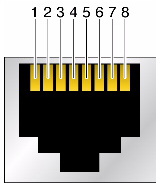Gigabit Ethernet Ports
The server has five auto-negotiating gigabit Ethernet (GbE) ports. Three Ethernet
ports use standard RJ-45 connectors, and two use enhanced small form-factor pluggable
(SFP+) port connectors. The transfer rates are shown in the following table.
Table 2 Ethernet Port Transfer Rates
|
|
|
|
Fast Ethernet
|
100BASE-T
|
100 Mbps
|
|
Gigabit Ethernet
|
1000BASE-T
|
1,000 Mbps
|
|
10 Gigabit Ethernet
|
10GBASE-T
|
10,000 Mbps
|
|
10/25 Gigabit Ethernet (SFP+)
|
10/25GbE
|
10,000/25,000 Mbps
|
|
RJ-45 10GbE Ports
The following figure and table describe the RJ-45 10GbE port pin signals.

Table 3 RJ-45 10GbE Port Signals
|
|
|
|
|
1
|
Transmit/Receive Data 0 +
|
5
|
Transmit/Receive Data 2 –
|
|
2
|
Transmit/Receive Data 0 –
|
6
|
Transmit/Receive Data 1 –
|
|
3
|
Transmit/Receive Data 1 +
|
7
|
Transmit/Receive Data 3 +
|
|
4
|
Transmit/Receive Data 2 +
|
8
|
Transmit/Receive Data 3 –
|
|
SFP+ 10/25GbE Ports
The following table describes the SFP+ 10/25GbE port pin signals.
Table 4 SFP+ 10/25GbE Port Signals
|
|
|
|
|
1
|
Transmitter ground (VeeT)
|
11
|
Receiver ground (VeeR)
|
|
2
|
Transmitter fault indication (TxFault)
|
12
|
Inverted received data (RD-)
|
|
3
|
Optical output disabled when high (TxDisable)
|
13
|
Received data (RD+)
|
|
4
|
Data for serial ID interface (MOD-DEF(2))
|
14
|
Receiver ground (VeeR)
|
|
5
|
Clock for serial ID interface (MOD-DEF(1))
|
15
|
Receiver power (VccR)
|
|
6
|
Grounded by the module to indicate module presence
(MOD-DEF(0))
|
16
|
Transmitter power (VccT)
|
|
7
|
Low selects reduced bandwidth (RateSelect)
|
17
|
Transmitter ground (VeeT)
|
|
8
|
When high, indicates received optical power below worst-case
receiver sensitivity (LOS)
|
18
|
Transmit data (TD+)
|
|
9
|
Receiver ground (VeeR)
|
19
|
Inverted transmit data (TD-)
|
|
10
|
Receiver ground (VeeR)
|
20
|
Transmitter ground (VeeT)
|
|
